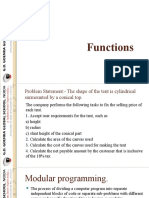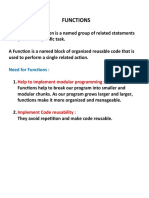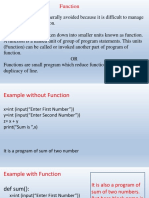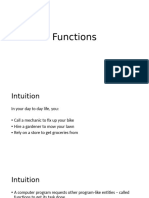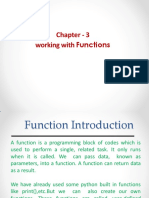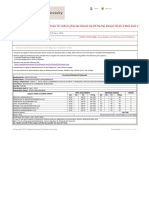0 ratings0% found this document useful (0 votes)
6 viewsFunctions
Uploaded by
mohammedawaiz112316Copyright
© © All Rights Reserved
Available Formats
Download as DOCX, PDF, TXT or read online on Scribd
0 ratings0% found this document useful (0 votes)
6 viewsFunctions
Uploaded by
mohammedawaiz112316Copyright
© © All Rights Reserved
Available Formats
Download as DOCX, PDF, TXT or read online on Scribd
You are on page 1/ 11
FUNCTIONS
The process of dividing a computer program into separate independent
blocks of code or separate sub-problems with different names and specific
functionalities is known as modular programming.
Functions:
Function can be defined as a named group of instructions that accomplish a
specific task when it is asked.
Once defined, a function can be called repeatedly from different places of
the program without writing all the codes of that function every time, or it
can be called from inside another function, by simply writing the name of
the function and passing the required parameters.
Advantages of Functions:
1. Increases readability, for longer code because the program is better
organized and easy to understand.
2. Reduces code length as same code is not required to be written at
multiple places in a program. This also makes debugging easier.
3. Increases reusability, as function can be called from another function
or another program. Thus, we can reuse or build upon already
defined functions and avoid repetitions of writing the same piece of
code.
4. Work can be easily divided among team members and completed in
parallel.
There are two types of functions:
Library Functions and User Defined Functions
Library Functions: There are many functions already available in Python
under standard library. We can call them directly without defining them,
this is called library functions.
User Defined Functions: a function defined to achieve some tasks as per
the programmer's requirement is called a user defined function.
Creating User Defined Functions:
A function definition begins with def (short for define).
The items enclosed in "[ ]" are called parameters and they are optional.
Hence, a function may or may not have parameters. Also, a function may or
may not return a value.
Function header always ends with a colon (:).
Function name should be unique. Rules for naming identifiers also applies
for function naming.
The statements outside the function indentation are not considered as part
of the function.
Write a user defined function to add 2 numbers and display their sum.
#Function to add two numbers
#The requirements are listed below:
#1. We need to accept 2 numbers from the user. #2. Calculate their sum
#3. Display the sum.
#function definition
def addnum():
fnum = int(input("Enter first number: "))
snum = int(input("Enter second number: "))
sum = fnum + snum
print("The sum of ",fnum,"and ",snum,"is ",sum)
#function call
addnum()
Arguments and Parameters:
An argument is a value passed to the function during the function call
which is received in corresponding parameter defined in function header.
Write a program using a user defined function that displays sum of first n
natural numbers, where n is passed as an argument.
#Program to find the sum of first n natural numbers
#function header
def sumN(n): #n is the parameter
sum = 0
for i in range(1,n+1):
sum = sum + i
print("The sum of first",n,"natural numbers is: ",sum)
num = int(input("Enter the value for n: "))
#num is an argument referring to the value input by the user sumN(num)
#function call
Write a program using user defined function that accepts an integer
and increments the value by 5. Also display the id of argument (before
function call), id of parameter before increment and after increment.
def incrValue(num):
#id of Num before increment
print("Parameter num has value:",num,"\nid =",id(num)) num =
num + 5
#id of Num after increment
print("num incremented by 5 is",num,"\nNow id is ",id(num))
number = int(input("Enter a number: "))
print("id of argument number is:",id(number)) #id of Number
incrValue(number)
Write a program using a user defined function calcFact() to calculate
and display the factorial of a number num passed as an argument.
#Function to calculate factorial
def calcFact(num):
fact = 1
for i in range(num,0,-1):
fact = fact * i
print("Factorial of",num,"is",fact)
num = int(input("Enter the number: "))
calcFact(num)
String as Parameters:
Write a program using a user defined function that accepts the first
name and lastname as arguments, concatenate them to get full name
and displays the output as:
def fullname(first,last):
#+ operator is used to concatenate strings
fullname = first + " " + last
print("Hello",fullname)
#function ends here
first = input("Enter first name: ")
last = input("Enter last name: ")
fullname(first,last) #function call
OUTPUT:
Enter first name: Soda
Enter last name: Bottlewala
Hello Soda Bottlewala
Default Parameter: A default value is a value that is predecided and
assigned to the parameter when the function call does not have its
corresponding argument.
Write a program that accepts numerator and denominator of a
fractional number and calls a user defined function mixedFraction()
when the fraction formed is not a proper fraction. The default value of
denominator is 1. The function displays a mixed fraction only if the
fraction formed by the parameters does not evaluate to a whole
number.
def mixedFraction(num,deno = 1):
remainder = num % deno
#check if the fraction does not evaluate to a whole number
if remainder!= 0:
quotient = int(num/deno)
print("The mixed fraction=", quotient,"(",remainder, "/",
deno,")") else:
print("The given fraction evaluates to a whole number")
#function ends here
num = int(input("Enter the numerator: "))
deno = int(input("Enter the denominator: "))
print("You entered:",num,"/",deno)
if num > deno: #condition to check whether the fraction is improper
mixedFraction(num,deno) #function call
else:
print("It is a proper fraction")
Functions returning value:
The functions that do not return a value is called void function.
When we must send value(s) from the function to its calling function, it is
done using return statement.
The return statement does the following : a) returns the control to the
calling function . b) return value(s) or none.
Write a program using user defined function calcPow() that accepts
base and exponent as arguments and returns the value Bas e exponent where
Base and exponent are integers.
def calcpow(number,power): #function definition
result = 1
for i in range(1,power+1):
result = result * number
return result
base = int(input("Enter the value for the Base: "))
expo = int(input("Enter the value for the Exponent: "))
answer = calcpow(base,expo) #function call
print(base,"raised to the power",expo,"is",answer)
Different types of functions are:
• Function with no argument and no return value
• Function with no argument and with return value(s)
• Function with argument(s) and no return value
• Function with argument(s) and return value(s)
Flow of execution:
The interpreter starts executing in a program from the first statement.
When the interpreter encounters a function definition, the statements
inside the function are not executed until the function is called. When the
interpreter encounters a function call, the control jumps to the function
rather than the next statement and executes the statement of the function.
The control then comes back to execute the remaining statements. It is also
important to note that a function must be defined before its call within a
program.
Write a program using user defined function that accepts length and
breadth of a rectangle and returns the area and perimeter of the
rectangle.
def calcAreaPeri(Length,Breadth):
area = length * breadth
perimeter = 2 * (length + breadth)
#a tuple is returned consisting of 2 values area and perimeter
return (area,perimeter)
l = float(input("Enter length of the rectangle: "))
b = float(input("Enter breadth of the rectangle: "))
#value of tuples assigned in order they are returned
area,perimeter = calcAreaPeri(l,b)
print("Area is:",area,"\nPerimeter is:",perimeter)
Scope of a Variable:
A variable defined inside a function cannot be accessed outside. The part of
the program where a variable is accessible is called scope of a variable.
The two types are: Global variable and local variable.
Global Variable: A variable that is defined outside any function or any
block is known as a global variable. It can be accessed in any functions
which is defined later. Any change made to the global variable will impact
all the functions in the program where that variable can be accessed.
Local Variable: A variable that is defined inside any function or a block is
known as a local variable. It can be accessed only in the function or a block
where it is defined. It exists only till the function executes.
Python Standard library: It is a collection of many built in functions that can
be called in a program when required.
Built in functions: they are readymade functions used in python that are
frequently used in a program.
Module:
A group of functions is called a module. The program is divided into
different parts under different levels called modules.
To use a module, we need to import them and we can directly use all the
functions of that module.
import modulename1(,modulename2,…)
To call a function of a module, the function should be preceded with the
name of the module with a dot(.) as a separator.
modulename.functionname()
Built-in modules:
Import statement can be written anywhere in the program. Module must be
imported only once. To get a list of modules available in Python, we can use
the following statement: >>> help("module").To view the content of a
module say math, type the following: >>> help("math").
From statement:
Instead of loading all the functions into memory by importing a module,
from statement can be used to access only the required functions from a
module. It loads only the specified function(s) instead of all the functions in
a module.
Its syntax is
>>> from modulename import functionname [, functionname,...].
>>> from random import random
>>> random() #Function called without
the module name
Output: 0.9796352504608387
>>> from math import ceil,sqrt
>>> value = ceil(624.7)
>>> sqrt(value)
Output: 25.0
You might also like
- Graded Quiz - Advanced SQL For Data Engineers71% (7)Graded Quiz - Advanced SQL For Data Engineers3 pages
- Eyoyo BT 2D Barcode Scanner. User Manual. Model - Youtube67% (3)Eyoyo BT 2D Barcode Scanner. User Manual. Model - Youtube36 pages
- Retreats Ora Grodsky and Jeremy PhillipsNo ratings yetRetreats Ora Grodsky and Jeremy Phillips11 pages
- Function-3 (1) Bghvynchbvhhhhhvvvbb. Bbb. VNo ratings yetFunction-3 (1) Bghvynchbvhhhhhvvvbb. Bbb. V7 pages
- Computer Science Class-Xii Code No. 083 2021-22: Functions in PythonNo ratings yetComputer Science Class-Xii Code No. 083 2021-22: Functions in Python21 pages
- Abu Hamour Branch, Doha - Qatar: M.E.S Indian School (Mesis)No ratings yetAbu Hamour Branch, Doha - Qatar: M.E.S Indian School (Mesis)9 pages
- FALLSEM2024-25_BCSE101E_ELA_VL2024250107585_2024-10-05_Reference-Material-INo ratings yetFALLSEM2024-25_BCSE101E_ELA_VL2024250107585_2024-10-05_Reference-Material-I57 pages
- Python Advanced Programming: The Guide to Learn Python Programming. Reference with Exercises and Samples About Dynamical Programming, Multithreading, Multiprocessing, Debugging, Testing and MoreFrom EverandPython Advanced Programming: The Guide to Learn Python Programming. Reference with Exercises and Samples About Dynamical Programming, Multithreading, Multiprocessing, Debugging, Testing and MoreNo ratings yet
- Fundamentals of Backend Engineering NotesNo ratings yetFundamentals of Backend Engineering Notes183 pages
- Safety Data Sheet Sds #: Ninjaflex Semiflex: 1. Product and Company IdentificationNo ratings yetSafety Data Sheet Sds #: Ninjaflex Semiflex: 1. Product and Company Identification5 pages
- Instant ebooks textbook Financial Sector Development in Ghana: Exploring Bank Stability, Financing Models, and Development Challenges for Sustainable Financial Markets James Atta Peprah download all chapters100% (4)Instant ebooks textbook Financial Sector Development in Ghana: Exploring Bank Stability, Financing Models, and Development Challenges for Sustainable Financial Markets James Atta Peprah download all chapters76 pages
- TB2-SDC - VPM210171-00100-M-M1B-PFD-0001 Rev0No ratings yetTB2-SDC - VPM210171-00100-M-M1B-PFD-0001 Rev023 pages
- CIAC Arbitration EO 1008 Ceniza Lecture - 38 PagesNo ratings yetCIAC Arbitration EO 1008 Ceniza Lecture - 38 Pages38 pages
- How To Calculate Notice Timedkading Master For Stopping The Cargo... Here Is The Answer - MySeaTimeNo ratings yetHow To Calculate Notice Timedkading Master For Stopping The Cargo... Here Is The Answer - MySeaTime4 pages
- Lr2170sa 4ah Specification Sheet TranslatedNo ratings yetLr2170sa 4ah Specification Sheet Translated15 pages
- Instalación Sensor Turbo Modificación 3-38-14en1No ratings yetInstalación Sensor Turbo Modificación 3-38-14en11 page
- Drying Wet Framing JLC June 2013 ArticleNo ratings yetDrying Wet Framing JLC June 2013 Article5 pages
- Title: Tilt Cylinder Model Number: 863 Serial Number: 514440001 & Above, 514540001 & Above, 514640001 & AboveNo ratings yetTitle: Tilt Cylinder Model Number: 863 Serial Number: 514440001 & Above, 514540001 & Above, 514640001 & Above3 pages
- Welcome To Saurashtra University Naimish Sem 4 BcomNo ratings yetWelcome To Saurashtra University Naimish Sem 4 Bcom1 page
- Eyoyo BT 2D Barcode Scanner. User Manual. Model - YoutubeEyoyo BT 2D Barcode Scanner. User Manual. Model - Youtube
- Computer Science Class-Xii Code No. 083 2021-22: Functions in PythonComputer Science Class-Xii Code No. 083 2021-22: Functions in Python
- Abu Hamour Branch, Doha - Qatar: M.E.S Indian School (Mesis)Abu Hamour Branch, Doha - Qatar: M.E.S Indian School (Mesis)
- FALLSEM2024-25_BCSE101E_ELA_VL2024250107585_2024-10-05_Reference-Material-IFALLSEM2024-25_BCSE101E_ELA_VL2024250107585_2024-10-05_Reference-Material-I
- Python Advanced Programming: The Guide to Learn Python Programming. Reference with Exercises and Samples About Dynamical Programming, Multithreading, Multiprocessing, Debugging, Testing and MoreFrom EverandPython Advanced Programming: The Guide to Learn Python Programming. Reference with Exercises and Samples About Dynamical Programming, Multithreading, Multiprocessing, Debugging, Testing and More
- Safety Data Sheet Sds #: Ninjaflex Semiflex: 1. Product and Company IdentificationSafety Data Sheet Sds #: Ninjaflex Semiflex: 1. Product and Company Identification
- Instant ebooks textbook Financial Sector Development in Ghana: Exploring Bank Stability, Financing Models, and Development Challenges for Sustainable Financial Markets James Atta Peprah download all chaptersInstant ebooks textbook Financial Sector Development in Ghana: Exploring Bank Stability, Financing Models, and Development Challenges for Sustainable Financial Markets James Atta Peprah download all chapters
- CIAC Arbitration EO 1008 Ceniza Lecture - 38 PagesCIAC Arbitration EO 1008 Ceniza Lecture - 38 Pages
- How To Calculate Notice Timedkading Master For Stopping The Cargo... Here Is The Answer - MySeaTimeHow To Calculate Notice Timedkading Master For Stopping The Cargo... Here Is The Answer - MySeaTime
- Title: Tilt Cylinder Model Number: 863 Serial Number: 514440001 & Above, 514540001 & Above, 514640001 & AboveTitle: Tilt Cylinder Model Number: 863 Serial Number: 514440001 & Above, 514540001 & Above, 514640001 & Above
- Welcome To Saurashtra University Naimish Sem 4 BcomWelcome To Saurashtra University Naimish Sem 4 Bcom



